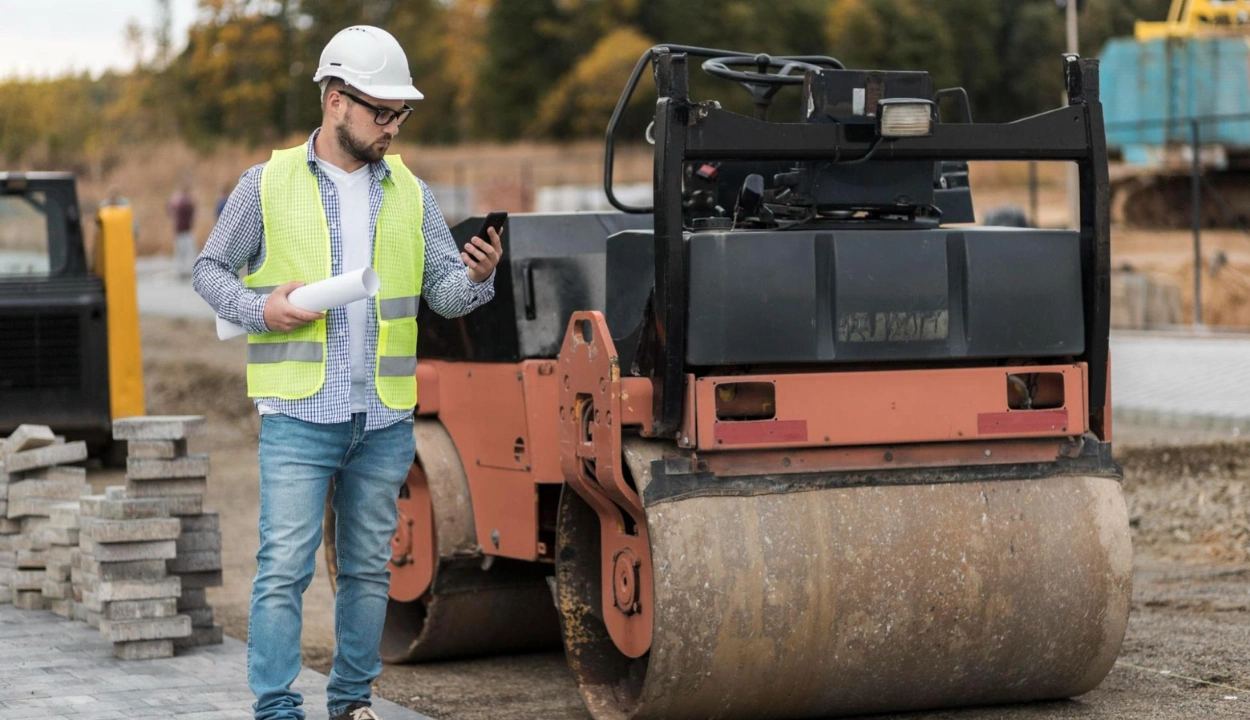Tracking Construction Equipment: Understanding the What's, Why’s and How’s?
The construction industry is not without its challenges. Equipment managers have their work cut out for them daily. They have to deal with everything from labor shortages to thefts and supplier issues.
One of the biggest challenges that equipment managers face is tracking their diverse range of equipment.
Tracking construction equipment allows construction companies to monitor, manage, and optimize their assets effectively.
What is construction equipment tracking, and how can it be done? Let’s examine the topic together.
What is Construction Equipment Tracking & How Do You Track Assets?
%2520(1)%2520(1).webp)
Let's start with the basics. Construction equipment tracking systems are tech solutions that help construction companies keep an eye on where their equipment is, how it is doing, and how well it works.
In the past, project managers had to check on things manually, which led to hassles and team mix-ups.
But thanks to new tech, it's now easier to track construction equipment.
Using telematics and GPS tracking, construction equipment companies can oversee their fleets remotely and get all the information they need in a single pane of glass solution.
Construction equipment tracking is conducted through devices and sensors installed directly on the equipment.
These devices directly communicate with the tracking platforms via GPS signals or cellular networks like 4G and, most recently, 5G.
Fleet managers can visualize their entire fleet’s status at a glance using user-friendly dashboards offered by construction equipment tracking systems.
Benefits of Real-Time Tracking
Tracking construction equipment has been made easy with real-time tracking, which offers significant advantages over traditional methods.
Gone are the days when construction project managers had to rely on manual logs and verbal updates.
With a GPS tracker for construction equipment, managers can get real-time insights into the equipment's whereabouts, run times, and maintenance status.
These frequent updates are critical in the fleet decision-making processes, especially for large fleets that operate on multiple sites.
For example, managers can identify inefficiencies and reduce downtime by tracking fuel consumption and machine usage through tracking devices for construction equipment.
What are The Types Of Equipment Trackers?
Construction tracking systems come in different forms, all tailored to various needs. Understanding these solutions helps construction companies choose the right technology for their needs.
Some examples of equipment trackers include:
GPS Trackers
GPS tracking for construction equipment is the most widely used method for monitoring heavy machinery.
GPS trackers are small devices that rely on satellite technology to provide users with precise vehicle or equipment locations.
These trackers can be installed on large machines like bulldozers, cranes, and smaller construction tools.
A GPS tracker for construction equipment is the most affordable and straightforward solution for many construction businesses.
It allows companies to pinpoint the location of their equipment and monitor its movement in real-time.
Monitoring equipment location can help project managers optimize usage, reduce idle time, and protect equipment well.
Pros and Cons of GPS Trackers
Telematics Systems
Telematics systems go beyond simple location tracking by integrating the machinery's operations.
These systems collect engine diagnostics, fuel consumption, and hydraulic system performance data.
A construction equipment tracking system with telematics delivers detailed insights into how equipment performs on a granular level.
These systems monitor the speed, idle time, fuel usage, and machine health of equipment.
This data is valuable for preventive maintenance and performance optimization.
Construction companies rely on telematics to develop better maintenance schedules, detect operational inefficiencies, and ensure equipment performance at its peak.
According to berginsight, It is speculated that 111 million OEM telematics systems for construction equipment will be installed worldwide by 2027.
Pros and Cons of Telematics Systems
Hybrid Systems
Hybrid tracking systems combine the benefits of GPS and telematics. This system lets you get GPS location insights and deep data analytics provided by telematics.
A hybrid solution is ideal for large construction operations needing location data and operational insights.
Hybrid systems are highly customizable, allowing construction companies to monitor everything with GPS tracking for construction equipment.
Pros and Cons of Hybrid Systems
Why is Asset Tracking Needed?
%2520(1).webp)
Asset tracking is required for construction companies if they want to remain competitive, productive, and efficient.
Tracking construction equipment helps you ensure that machinery operates safely, is well-maintained, and is used properly.
Here is a deeper look at why asset tracking is required in the construction industry.
Safety
Safety is always the priority for any construction site. Construction equipment tracking software helps you to enhance the safety of fleets by ensuring that they are trackable in real-time.
Construction equipment tracking systems alert equipment managers if the equipment enters restricted areas or if the operators exceed safe operation limits.
These alerts can differentiate between safe operations and dangerous incidents in high-risk environments.
Tracking systems can also integrate with operator IP cards, helping to ensure that only authorized personnel can operate specific machinery.
Longevity of Equipment
Heavy machinery requires heavy investments, so caring for it to extend its lifespan is essential. With GPS tracking for construction equipment, you can easily monitor how often and overworked the equipment is.
This information is very helpful in scheduling maintenance activities, allowing construction companies to extend the machinery's lifespan.
Maintenance data collected through construction equipment GPS tracking also helps identify trends and patterns in equipment wear, allowing for more strategic long-term planning.
Improved Equipment Utilization
Improving equipment utilization is one of the most critical benefits of construction equipment & fleet tracking.
Idle machinery represents wasted potential and costs money.
By tracking equipment usage, fleet managers can ensure that machines are used to their full potential and redistributed where necessary.
Theft Prevention and Recovery
Theft is a persistent problem in the construction industry. Because construction equipment is expensive, it is a prime target for theft.
Tracking devices for construction equipment makes locating and recovering stolen assets easier.
Some GPS systems also include geofencing, sending alerts when equipment leaves a designated area, and helping prevent unauthorized movement.
Maintenance Management
Without regular maintenance, construction equipment cannot perform efficiently.
Using GPS construction equipment tracking, managers can track machinery run times and schedule maintenance based on actual usage.
This helps plan proactively and avoid breakdowns and delays that lead to disruption in the project timelines.
Cost Savings
Efficient use of construction equipment leads to significant cost savings, which can be achieved by properly maintaining the equipment and ensuring that extra rentals are not made.
Companies can avoid unnecessary rentals using the best GPS tracker for construction equipment.
This is an excellent factor in ensuring the optimal usage of owned equipment and reducing fuel costs through better route planning and reduced idling.
Enhanced Productivity
With tracking for construction equipment, companies can track operational data and make informed decisions on how to optimize job site efficiency.
For example, managers can ensure the right equipment is on-site and reduce project delays caused by machine shortages or breakdowns.
Resource Management
Effective resource management is the most significant contributing factor to a construction project's success.
By tracking construction equipment, companies can ensure they have the correct number of machines for each project.
This is important because unnecessary equipment results in wasted funds and can make the site more prone to theft and wastage.
Construction managers can significantly improve resource allocation and reduce waste through effective resource management.
How Can Asset Tracking Software Help
Construction asset tracking software takes your equipment to the next level by adding extra features that make asset management more effortless.
Here is how:
Reminders and Alerts
Using construction equipment tracking software, fleet managers can automate reminders for routine tasks such as maintenance, inspections, and fuel top-ups.
These real-time notifications ensure that the machinery is running in optimal conditions.
Site managers can automate data-driven maintenance, inspections, and fuel-up reminders.
This ensures that the equipment is always running at its best.
Remote Access
With cloud-based construction equipment GPS tracker platforms, fleet managers can access their equipment data from anywhere.
Remote access means they can make decisions in real-time even if they’re not on-site, reducing downtime and improving overall fleet efficiency.
Visibility
When using construction GPS tracker systems, every piece of equipment's movement, use, and performance is logged and made available for review.
With real-time tracking, you have a transparent workflow view, where all parties can access the data required to make decisions.
Asset Management
Companies can better manage their assets by using tracking software for construction equipment.
This system allows managers to view their assets' locations in real-time. This allows project managers to use equipment more, maintain it on time, and forecast projects better.
Fuel Management and Control
Fuel is an enormous cost in fleet operations, especially for large construction projects.
Asset tracking software can track fuel consumption in real time to see trends and where fuel is wasted.
Construction equipment GPS tracking insights will show you issues like excessive idling, inefficient routes, or underperforming machines, all of which waste fuel.
You can reduce fuel costs and better manage your budget by improving fuel efficiency and route planning.
Security Alerts
Asset tracking software has a geo-fencing function, allowing you to set virtual boundaries for your equipment.
The system will alert you if a machine moves outside a defined area (like a job site or storage yard). This feature is handy for preventive theft, unauthorized usage, and misplaced equipment.
Construction equipment tracking devices can send instant notifications if they detect equipment tampering. This helps increase security and reduce insurance premiums.
Environment Monitoring
Some tracking systems also have environmental impact monitoring, which tracks equipment’s carbon footprint and emissions levels.
This is very useful for companies focused on sustainability.
Fleet managers can easily reduce environmental impact using a construction equipment GPS tracker solution that provides emission data.
This is done by identifying high-emission equipment and making informed decisions to invest in more eco-friendly alternatives.
This also helps companies meet environmental regulations and reporting requirements.
Data Integration
Most construction equipment tracking software can easily be integrated with other management systems, such as ERP, HCSS, project management, and accounting software.
This integration seamlessly shares data across platforms, giving fleet managers a holistic view of their operations.
By integrating data from multiple sources, construction companies make strategic decisions related to fleet management, budgeting, and resource allocation.
Conclusion
Clue's tracking construction equipment has become necessary for any company looking to compete in the construction landscape.
Telematics and GPS tracking systems provide insights that allow construction companies to enhance safety, optimize resources, prevent thefts, and reduce maintenance costs.
Whether you are a small contractor or a large fleet owner, incorporating construction equipment tracking into your operation is essential to help you stay efficient, competitive, and profitable.
FAQs
Can tracking devices be used on small tools?
Yes, small tools can be tracked using specialized compact tracking devices. These devices provide essential location and usage data for smaller tools, often high-theft-risk items that need to be accounted for.
What technologies are used in equipment tracking?
Standard technologies include GPS, and telematics. GPS provides location data, while telematics offers in-depth insights into equipment performance and health.
Is construction equipment tracking expensive?
The cost of equipment tracking varies depending on the system. Basic GPS trackers for construction equipment solutions are relatively affordable, while advanced telematics systems can be more expensive but offer more profound insights.
How does tracking help with equipment maintenance?
Tracking allows fleet managers to schedule maintenance based on actual equipment use, preventing breakdowns, reducing repair costs, and extending the operational life of machinery.
Can equipment tracking prevent theft?
Yes, tracking devices enable real-time monitoring, which allows for the quick recovery of stolen assets and provides alerts if equipment leaves designated areas.
Transform Your Equipment Management












